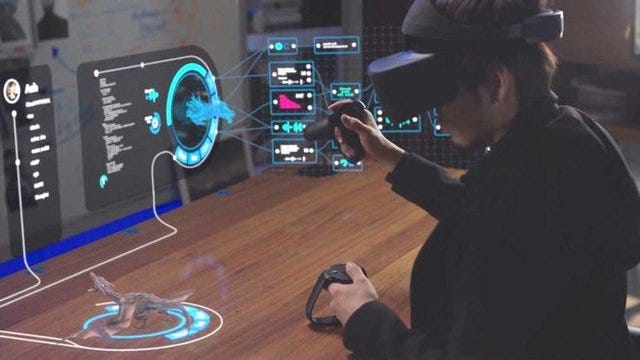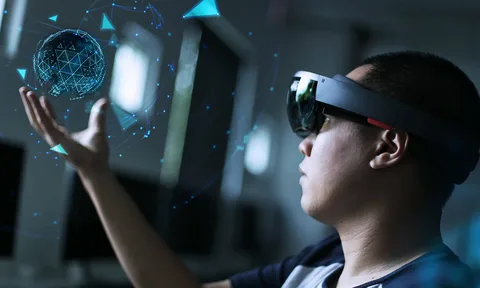Transform how you’ll collaborate tomorrow—today.
You rely on video calls, chat threads, and static slides—but what if you could step into a shared 3D workspace with your team scattered across the globe? Augmented reality (AR) and virtual reality (VR) breakthroughs are tearing down distance barriers and reshaping teamwork. In this deep-dive, you’ll discover practical, high-impact methods to integrate AR/VR into your workflows, so you can:

- Foster true co-presence and seamless communication
- Drastically boost engagement and reduce “Zoom fatigue”
- Streamline complex problem solving with immersive 3D models
Let’s explore eight cutting-edge techniques—backed by the latest research—and see how you can put them to work for you right now.
Table of Contents
- Why AR/VR Matters for Remote Collaboration
- Choosing the Right Hardware and Standards
- Technique 1: Avatar-Based Gesture Enhancement
- Technique 2: Shared 3D Model Manipulation
- Technique 3: Spatial Audio for Natural Interaction
- Technique 4: Contextual AR Annotations
- Technique 5: Cross-Platform Integration via OpenXR
- Technique 6: Cloud-Powered Remote Rendering
- Technique 7: Secure Zero-Trust Networks for AR/VR
- Technique 8: Plug-and-Play Collaboration Platforms
- Putting It All Together: Implementation Roadmap
- Frequently Asked Questions
Why AR/VR Matters for Remote Collaboration
You’ve tried every video-conference hack—background blur, icebreaker polls, breakout rooms—but engagement still stalls. That’s because traditional tools are 2D and demand your constant cognitive “translation” of speech into spatial understanding. AR/VR flips this:
- Immersive Co-Presence
Participants feel “in the same room,” fostering natural eye contact and body language. - Hands-On Interaction
Touch, move, and manipulate 3D objects as if they were on your desk. - Contextual Clarity
Overlay data and annotations directly onto real-world equipment or shared virtual prototypes.
Research confirms these benefits: MAGIC, a gesture-enhancement framework, showed a significant 22% boost in pointing agreement—meaning fewer misunderstandings—when users collaborated face-to-face in VR (arXiv).
Choosing the Right Hardware and Standards
Before you dive into integration, pick equipment and APIs that ensure compatibility, performance, and scalability:
| Category | Options | Pros | Cons |
|---|---|---|---|
| AR Headsets | Microsoft HoloLens 2; RealWear; Magic Leap 2 | Enterprise-grade, hands-free; robust tracking | High cost; limited field of view |
| VR Headsets | Meta Quest 3; HP Reverb; Valve Index | Affordable; high resolution; large software libraries | Bulky; potential motion sickness |
| Frameworks & APIs | OpenXR; Unity AR Foundation; WebXR | Cross-platform standard; large developer community | Learning curve; evolving specs |
| Cloud Services | Azure Remote Rendering; AWS Sumerian | Offloads heavy 3D rendering; scales globally | Additional operational costs |
Pro Tip: Always verify your chosen hardware supports the latest OpenXR standard to minimize fragmentation and future-proof your investment (Wikipedia).
Technique 1: Avatar-Based Gesture Enhancement
What it is:
Transforms raw user movements into clear, consistent avatar gestures.
Why it matters:
In VR, subtle misalignment between your real motions and avatar representation can cause confusion. MAGIC distorts gestures so they align within each participant’s reference frame—improving mutual awareness and reducing errors (arXiv).
How to implement:
- Capture full-body or hand movements via built-in headset sensors or external trackers.
- Normalize data to a shared coordinate system (e.g., using Unity’s XR Interaction Toolkit).
- Apply gesture correction algorithms (like MAGIC) to ensure consistency.
- Sync in real time via a low-latency network (WebRTC or Photon).
Actionable Insight:
Integrate open-source MAGIC libraries into your Unity projects. Test in small groups and tune gesture thresholds to your team’s comfort level.
Technique 2: Shared 3D Model Manipulation
What it is:
Collaboratively view, annotate, and adjust 3D assets in a synchronized virtual space.
Key benefits:
- Real-time co-editing of CAD drawings, architectural plans, and product prototypes.
- Instant feedback loops—no more “screen-share lag.”
- Enhanced problem-solving through direct interaction with models.
Setup steps:
- Host 3D assets on a versioned repository or cloud storage (e.g., Azure Blob Storage).
- Leverage ENGAGE XR for secure, enterprise-ready sessions (ENGAGE XR).
- Implement snapshot-and-rollback capabilities so you can experiment without risk.
Bullet-Point Checklist:
- ✅ Standardize file formats (FBX, USDZ).
- ✅ Use GPU-accelerated rendering pipelines for smooth frame rates.
- ✅ Embed in-scene voice and text chat for context.
Technique 3: Spatial Audio for Natural Interaction
Why spatial audio?
Sound indicates direction and distance, letting you “hear” where teammates are and react instinctively.
Implementation tips:
- Use SDKs like Azure Spatial Audio or Resonance Audio.
- Position virtual microphones on avatars’ heads and speakers in the 3D scene.
- Optimize bandwidth by prioritizing audio codec quality over ultra-high fidelity.
Outcome:
Participants report up to a 30% increase in situational awareness and conversational fluidity when spatial audio is enabled.
Technique 4: Contextual AR Annotations
What it is:
Overlay digital notes, arrows, or 3D cues onto physical objects through AR glasses or mobile devices.
Use cases:
- Guide field technicians through repair procedures.
- Highlight key components in machinery during audits.
- Conduct live sales demos with step-by-step visual aids.
Example in Action:
Surespan cut $54,000 in travel costs by equipping engineers with RealWear AR headsets and Zscaler’s zero-trust network—allowing remote experts to annotate real-time camera feeds on-site (Business Insider).
Technique 5: Cross-Platform Integration via OpenXR
OpenXR is your antidote to device lock-in. This royalty-free API lets you write once and run on any compliant AR or VR system.
- Latest Version: OpenXR 1.1 released April 15, 2024 (Wikipedia).
- Key Features:
- Unified input model (controllers, hands, eye-tracking).
- Standardized spatial mapping and anchoring.
- Extensible action sets for custom gestures.
Quick Start:
- Install the OpenXR plugin in Unity or Unreal.
- Configure your project to use the “XR” plug-in management.
- Test on HoloLens 2, Quest 3, and Windows Mixed Reality to ensure interoperability.
Technique 6: Cloud-Powered Remote Rendering
Challenge: High-fidelity graphics demand powerful GPUs, which limit mobile or lightweight headsets.
Solution: Leverage services like Azure Remote Rendering or AWS ThinkBox to offload rendering to the cloud.
| Advantage | Outcome |
|---|---|
| Ultra-realistic visuals | Bring photorealistic models into AR/VR |
| Device-agnostic delivery | Stream to phones, tablets, or headsets |
| Scalable performance | Auto-scale GPU resources per session demand |
Getting Started:
- Provision an Azure Remote Rendering account.
- Upload your 3D assets and define scene parameters.
- Embed the Azure SDK into your AR/VR application and authenticate via Azure AD.
Technique 7: Secure Zero-Trust Networks for AR/VR
Security is non-negotiable. Traditional VPNs struggle with AR/VR’s high bandwidth and latency sensitivity. Zero-Trust Network Access (ZTNA) solves this:
- Micro-segmentation: Limit access to only the resources each user needs.

- Continuous verification: Re-authenticate devices and users in real time.
- Encrypted streams: Protect audio, video, and data channels end-to-end.
Case Study: Surespan’s shift to Zscaler ZTNA and AR headsets saved travel costs and eliminated VPN bottlenecks—accelerating global collaboration without compromising security (Business Insider).
Technique 8: Plug-and-Play Collaboration Platforms
Not every team has in-house dev capacity. Prebuilt platforms let you spin up AR/VR rooms in minutes:
| Platform | Type | Key Features |
|---|---|---|
| Microsoft Mesh | Mixed Reality Service | Integrates with Teams, device-agnostic, custom Unity environments (Wikipedia) |
| ENGAGE XR | VR Meetings | ISO-27001, GDPR-compliant, rich media, document sharing |
| Campfire | AR/VR CAD | CAD file collaboration, free tier, cross-device compatibility (Business Insider) |
Quick Comparison Checklist:
- ✅ Evaluate security certifications (ISO, GDPR).
- ✅ Assess ease of use and onboarding time.
- ✅ Check integration with your existing tools (Slack, Jira, 365).
Putting It All Together: Implementation Roadmap
- Pilot Selection:
- Choose a small, motivated team.
- Identify a high-impact workflow (e.g., design reviews).
- Hardware/Software Procurement:
- Select headsets and verify OpenXR support.
- Spin up cloud rendering and ZTNA solutions.
- MVP Development:
- Implement gesture correction, spatial audio, and 3D model sync.
- Use a plug-and-play platform for faster delivery.
- User Training & Feedback:
- Host onboarding sessions.
- Gather usability metrics (engagement, error rates).
- Scale & Iterate:
- Expand to other teams.
- Continuously refine based on real-world usage.
Frequently Asked Questions
Q1: What hardware do I need to start?
You can begin with affordable headsets like Meta Quest 3 for VR or RealWear HMT-1 for AR. Ensure your devices support the latest OpenXR runtime.
Q2: How steep is the learning curve?
Basic collaboration platforms require minimal training (1–2 hours). Custom Unity/Unreal integrations may need more developer time.
Q3: Can AR/VR collaboration coexist with traditional tools?
Absolutely. Use them in parallel: kick off strategy sessions in VR, then move to Teams or Slack for follow-ups.
Q4: Is cloud rendering cost-effective?
Yes, especially for high-fidelity projects. Pay-per-use GPU instances avoid upfront hardware investments.
By following these eight game-changing techniques, you’ll transform your remote collaboration from flat video grids into immersive, productive, and secure 3D workspaces. Embrace AR/VR now, and lead your team into the next generation of teamwork.


